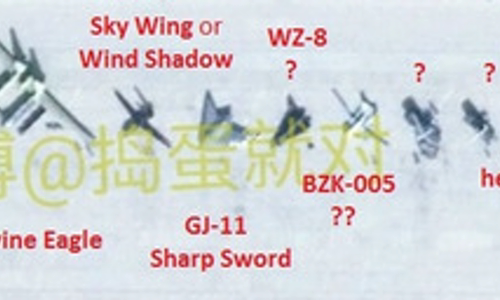Most of the unmanned aircraft on the Chinese payroll have appeared on photos of the Malan and Xinjiang bases.
A satellite image circulating on social networking site Weibo last weekend showed Chinese-developed drones (UAVs) lying on the apron of Malan Air Force Base in Xinjiang Autonomous Region. The timing of this satellite image was not announced.

UAV staging appeared at Malan military airport Photo: Weibo
The RupprechtDeino account, a follower of China's military situation, found the picture on Weibo and re-posted it on Twitter. This person thinks that this is a complete "family" of UAVs in China and is much larger than the UAVs that appeared in the image of the Malan base in August 2018.
"It represents Beijing's enormous investment effort with UAVs, from unmanned combat aircraft (UCAVs) to small aircraft, capable of operating in groups and easily replaceable," military expert Tyler Rogoway commented.
The UAV array consists of two high-altitude aircraft operations and long-haul reserve (HALE), the largest of which is the Goddess in the middle of the squad. Two stealth aircraft with the wings design application, Thien Ung and Loi Kiem, are also present alongside the Duc Long UCAV versions. An unmanned helicopter with UAVs operating in groups is also present on the apron.
"These are just a few of the unmanned aerial systems that China has revealed. There are many projects that are completely hidden or completely hidden by Beijing," Rogoway added.
China is now the world's largest UCAV exporter with 153 units sold to 13 countries between 2014-2018, according to a report published earlier this year by the Stockholm International Peace Research Institute (SIPRI).
The main customers of China include Egypt, Iraq, Jordan, Saudi Arabia and the United Arab Emirates (UAE). Beijing is willing to sell a variety of modern UCAVs without strict conditions like Washington, especially for Middle East countries in high demand.



 VersoGina
VersoGina







